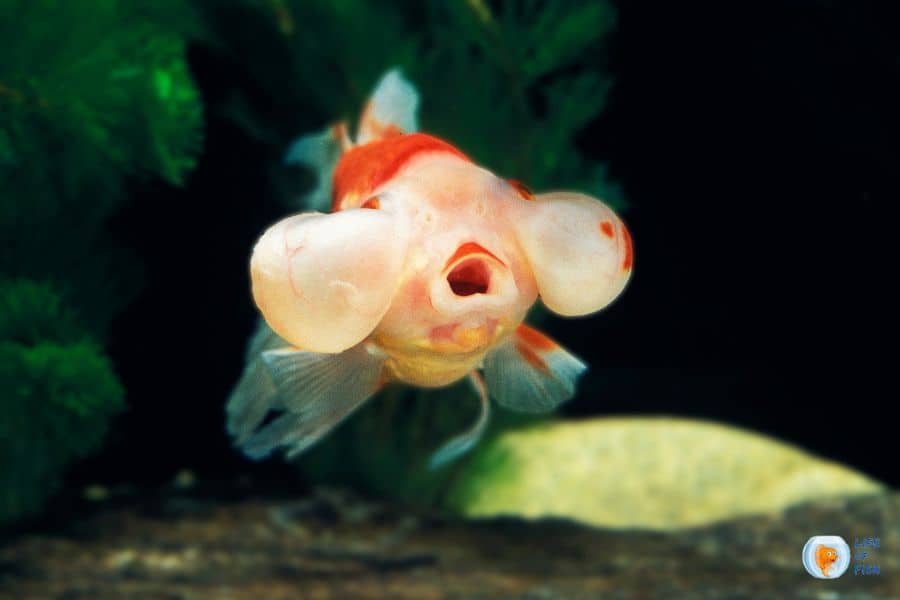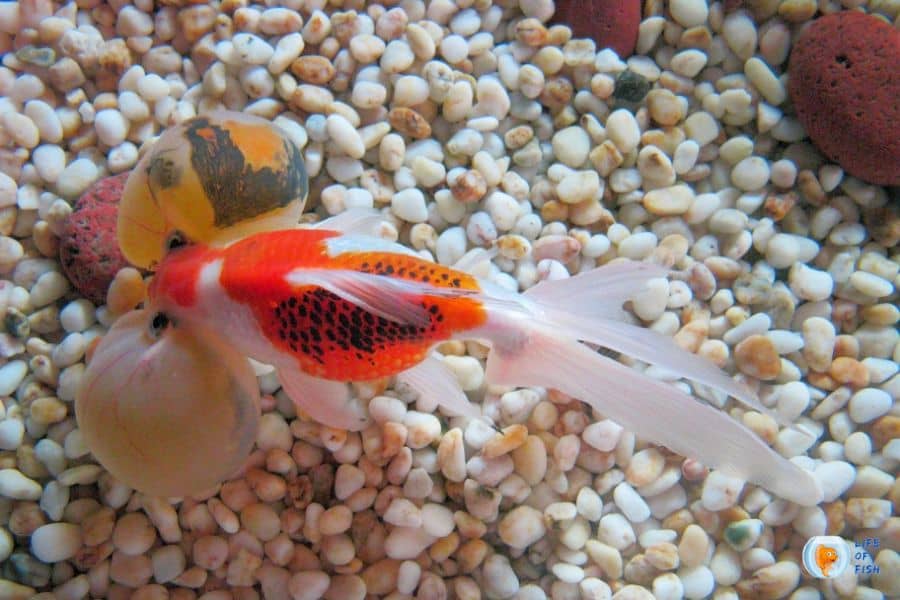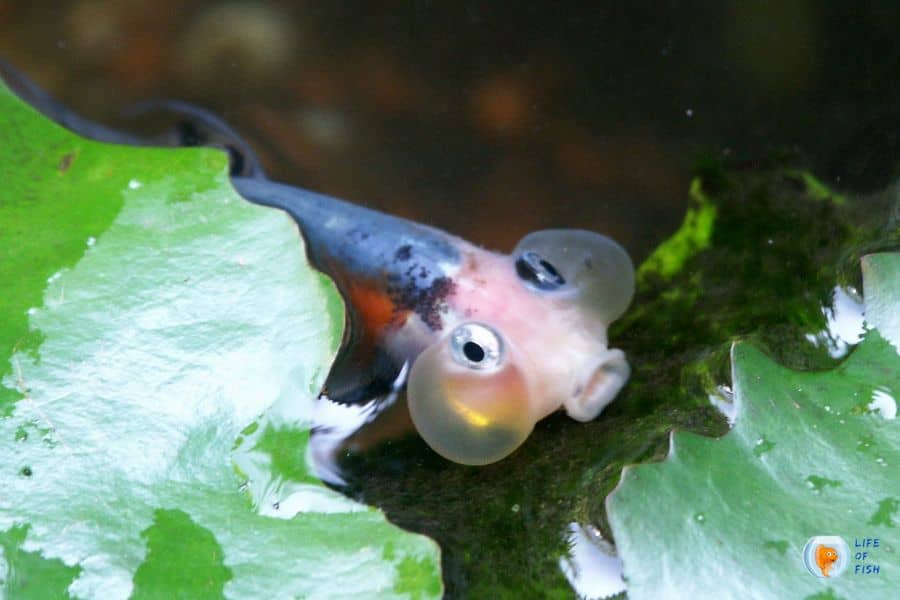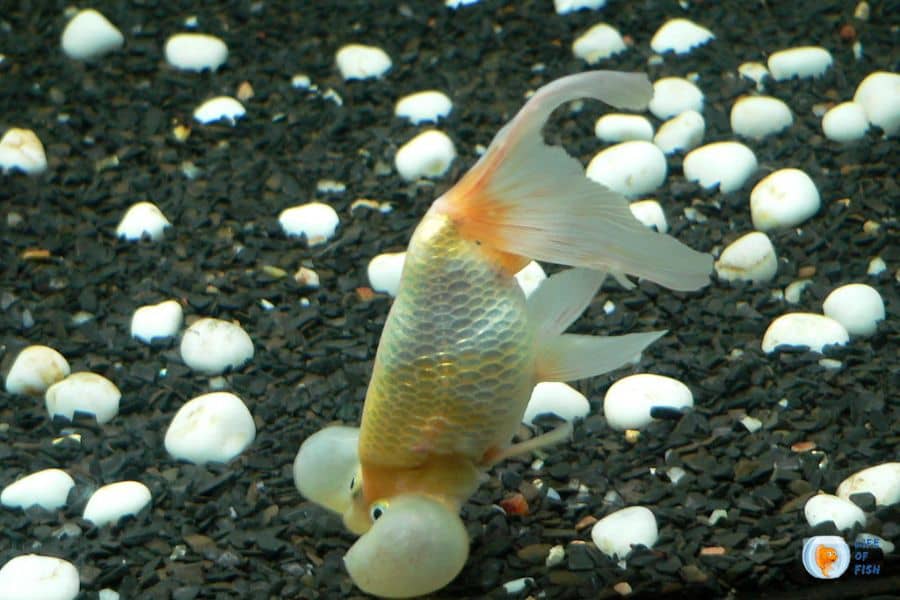Goldfish are unquestionably one of the most well-liked pets on Earth and come in various forms, sizes, and colors. Some goldfish may have unique characteristics, like double tails or bubble eye.
Bubble-eye goldfish are one of the most unique-looking goldfish out there. As their name suggests, they have large, round bubbles in their eyes. These bubbles are actually sacs filled with fluid. Because of their delicate eye shape, these goldfish require extra special care, unlike the common goldfish.
If you’re looking to purchase a bubble-eye goldfish or already have one, keep reading to discover all there is to know about caring for this unique fish.

One Look Care guide
Jump To
- 1 One Look Care guide
- 2 What is Bubble Eye Goldfish
- 3 Origins
- 4 Appearance
- 5 Is Bubble Eye Goldfish aggressive?
- 6 Bubble Eye Goldfish behavior
- 7 How long do Bubble Eye Gold Fishes live?
- 8 Bubble Eye Goldfish care
- 9 Bubble Eye Goldfish breeding
- 10 How to feed Bubble Eye Goldfish?
- 11 Bubble Eye Goldfish diseases
- 12 What fish can live with Bubble Eye Goldfish?
- 13 Conclusion
- 14 Related questions
| Scientific name | Carassius auratus |
| Common name | Bubble eye goldfish |
| Care level | Moderate |
| Native to | China, Crossbred |
| Type | Freshwater fish |
| Color | Vary |
| Tank size | Minimum 10 gallons |
| Preferred temperature | 65-75 degrees Fahrenheit |
| Other water parameters | pH level: 6.5-7.5 Hardness: 5-19KH Ammonia level: 0 ppm Nitrite level: 0 ppm Nitrate level: 20-40 ppm |
| Preferred salinity | No salinity |
| Size | 3 to 4 inches |
| Life Span | 5 to 10 years |
| Temperament | Peaceful |
| Recommended tank mates | Non-aggressive, peaceful tankmates |
| Preferred food | Omnivore, pellets, flakes, fresh, frozen and freeze-dried food |
| Feeding frequency | 2 times per day |
| Breeding | Easy, egg layers |
What is Bubble Eye Goldfish
Bubble-eye goldfish, sometimes referred to as the bubble-eyed goldfish, telescope goldfish, celestial goldfish, or pop-eyed goldfish, is a fancy goldfish breed that originated in China. It gets its name from the large, round sacs that form under their eyes. These sacs are filled with fluid and help the fish see better underwater.
They are a very popular pet and come in a range of colors, including orange, white, black, red, and yellow. It is a very delicate fish, though, and needs to be cared for properly.
Origins
They are originated in China in the early 20th century. It is a man-made fish created by selective breeding of the telescope goldfish. This distinct type of breed soon became popular in East Asia and then eventually made its way to the West.
Appearance
They are easily identified by their unique appearance. The fish has a protrusion on each side of its head below the eye that is filled with fluid. This gives the fish its name, as the protrusion looks like a bubble. These bubbles serve no useful function for the fish. They are a deformity that exists because some people find them attractive.
In addition, the fish typically lacks a dorsal fin, which is another distinguishing characteristic. The size of the bubble-eye goldfish varies, but they are typically between 3 and 4 inches long. The color of the fish also varies and can be orange, white, black, red, or yellow.

Is Bubble Eye Goldfish aggressive?
They are not an aggressive breed. They are typically peaceful fish that get along well with other goldfish and even tropical fish. However, because they lack a dorsal fin, they can be bullied by other fish. It’s important to make sure that they are in a tank with fish that won’t harass them.
Bubble Eye Goldfish behavior
Unlike the common goldfish, they are slow swimmers. This is due to their delicate eye sacs. These sacs can easily be ruptured if the fish swims too fast, so they need to swim slowly to avoid injury.
They are also bottom-dwellers. They prefer to be near the bottom of the tank, where it is quieter. In addition, bubble-eye Goldfish are not very active fish. They do not need a lot of space to swim and can even do well in a small tank.
How long do Bubble Eye Gold Fishes live?
This fish’s deformity causes some health issues that can shorten its lifespan. Bubble-eye goldfish typically live for 5–10 years, but with proper care, they can live for up to 15 years.

Bubble Eye Goldfish care
Because of their delicate eye sacs, bubble-eye goldfish require special care.
Bubble-eye goldfish need extra care for two primary reasons.
- Because eye protrusions stick out, they make it more difficult for Goldfish to swim since the jiggling slows them down while in motion. Oddly enough, Goldfish who use these bubbles also tend to adopt an unusual posture where their heads are typically pointed downwards.
- The bubbles are also delicate and easily punctured or infected. If the bubbles are ruptured, it can be very difficult for them to heal.
For these reasons, it’s important to take care when handling bubble-eye goldfish and to make sure that their tank is set up properly.
Bubble Eye Goldfish size
They are not large fish. They typically grow to be 3 to 4 inches long.
Bubble Eye Goldfish tank size
Even though they are small, they still need a reasonably sized tank. For each fish, aim for a tank that is at least 10 gallons. So, if you want to keep two bubble-eye goldfish, you should get a 20-gallon tank.
How many Bubble Eye Goldfish should be kept together?
Because they are slow-moving and peaceful fish, bubble-eye goldfish can be kept in groups. A good rule of thumb is to have one fish per 10 gallons of water. So, if you have a 20-gallon tank, you could keep two bubble-eye goldfish together. However, if you prefer, you can also keep only one fish in a tank.
Tank setup
Because of the exquisite eyesight of bubble-eye goldfish, it is important to have a tank that is set up properly. Since the eyes are more sensitive, you may have to add less stuff to the tank. For example, you may want to avoid using gravel that is too sharp or pointy.
You should also give your Goldfish plenty of open swimming area in the tank, as they are sluggish swimmers. You might also want to include some plants or other decorations where they can hide if they are scared or intimidated.
For the substrate, you can use any type of gravel or sand. Just be sure it’s not pointed or sharp.
As for plants, you can use live or fake ones. Just make sure that the plants are not too tall or bushy. They like to swim near the bottom of the tank, so you don’t want anything that will block their view.
For other decorations, you can use rocks, driftwood, or anything else that you think would look good in the tank. Just make sure that there are no sharp edges that could hurt the fish.
Filter
The filter is an important part of every aquarium. It aids in the maintenance of clean and filtered water. For bubble-eye goldfish, you will need a filter with a gentle water flow.
Bubble-eye goldfish are slow swimmers, and they can get easily stressed by a strong water flow. Also, a strong current can hurt their delicate eyes. So, it is important to get a filter with a gentle water flow. You can also use an air stone to create some water movement. Just make sure that the water movement is not too strong.
Lighting
For lighting, you can use either LED or fluorescent bulbs. Just make sure that the light is not too bright. Bubble-eye goldfish are sensitive to light, and they can get easily stressed by a bright light.
Lid
Bubble-eye goldfish are not good jumpers. But that doesn’t mean that you don’t need a lid for their tank. A cover is necessary to keep the water in the fish tank and prevent other animals from entering.
Water quality condition
Fortunately, bubble-eye goldfish are hardy like other goldfish. They can live in a wide range of water conditions. However, it is still important to maintain good water quality in their tank. To maintain good water quality, you will need to do a partial water change every week. During the water change, you should remove 20% of the water from the tank and replace it with fresh water.
In addition, you should also clean the filter every month. This will help remove any buildup of toxins in the water.
The ideal water parameters for bubble-eye goldfish are:
- pH level: 6.5-7.5
- Hardness: 5-19KH
- Ammonia level: 0 ppm
- Nitrite level: 0 ppm
- Nitrate level: 20-40 ppm
- Water temperature: 65-75 degrees Fahrenheit
Goldfish are cold-blooded animals, and they can’t regulate their own body temperature. So, it is important to maintain the water temperature in their tank.
If you want to make changes to the water parameters, do so gradually. Sudden changes in water parameters can be stressful for the fish, and they can even kill them.

Bubble Eye Goldfish breeding
The breeding of Bubble Eye Goldfish is more difficult than that of other goldfish species. They need a lot of space to spawn, and the parents tend to eat the eggs. However, if you can provide them with the right conditions, they will eventually spawn.
The best way to get your Bubble Eye Goldfish to breed is to gradually increase the water temperature from about 60 °F to 68 °F. Once they reach 68 °F, you should start seeing some spawning activity.
The male will start following the female around and eventually push her against a plant or spawning mop. The female will then release her eggs, and the male will fertilize them. However, both parents tend to target and eat the eggs, so you have to remove them after they’ve spawned.
In a few days, the goldfish eggs will hatch, and baby goldfish will emerge. They’ll be dark in color, have no bubble eyes, and won’t look like their parents at all. They’ll also have no scales, which will make them very vulnerable to predators.
To prevent the baby goldfish from being eaten, you should remove them to a separate tank. You can then raise them until they’re big enough to be added to the main tank.
How many babies do Bubble Eye Goldfish have?
Bubble Eye Goldfish can lay up to 500 eggs per spawn. However, not all of the eggs will hatch, and even fewer of the fry will survive to adulthood. So, if you want to raise a few baby goldfish, you should expect to start with at least 50 eggs.
Bubble Eye Goldfish fry care
As we mentioned before, bubble-eye goldfish are very delicate when they’re young. They have no scales, and their eyes are still developing, so they’re very vulnerable to predators and diseases.
To increase their chances of survival, you should remove the fry to a separate tank as soon as they’re born. The fry tank should have soft, clean water with a temperature of about 68–72 °F.
You should also provide the fry with plenty of hiding places. You can use plants, rocks, or pieces of driftwood for this purpose. The fries will also need food. You can either feed them live food or commercially fried food.
After a few weeks, the fry will begin to develop scales, and their eyes will become more prominent. At this point, you can start slowly acclimating them to the main tank.
How to feed Bubble Eye Goldfish?
Bubble Eye Goldfish are not fussy eaters, and they will accept most types of food. It’s also necessary to offer them a diet that is high in protein and low in carbohydrates. Live food, such as brine shrimp, daphnia, or bloodworms, is the best option for this. You can also feed them frozen or freeze-dried versions of these foods.
You can also give them pellets or flakes, but make sure that they’re high in protein and low in carbohydrates. In general, you should feed your goldfish twice a day. Offer them as much food as they can consume in 2-3 minutes.
Bubble Eye Goldfish diseases
Bubble Eye Goldfish are prone to the same diseases as other goldfish breeds. The most common diseases include Ich, velvet, and fin rot.
- Ich is a parasite that attacks the fish’s skin and fins. White spots on the skin and fins, as well as lethargy and loss of appetite, are all signs of this disease.
- Velvet is another parasite that attacks the fish’s skin. The symptoms include a yellow or brownish tint to the skin, as well as lethargy and a loss of appetite.
- Fin rot is a bacterial infection that attacks the fish’s fins. The symptoms include fraying or disintegration of the fins, as well as redness and inflammation.
If you notice any of these symptoms in your fish, you should take it to a veterinarian for treatment.
What fish can live with Bubble Eye Goldfish?
Bubble Eye Goldfish can live with other goldfish varieties as well as many other peaceful fish. Some good choices include platies, mollies, gobies, and tetras. You should avoid keeping Bubble Eye Goldfish with aggressive fish, such as cichlids and sharks. These fish may bully or even eat the smaller goldfish.
However, keep them with peaceful snails and shrimps. These animals will help to keep the tank clean, and they won’t bother the goldfish.
Conclusion
Bubble Eye Goldfish is a beautiful and unique fish that makes a great addition to any aquarium. They’re easy to care for, but they do have some special requirements. If you can provide them with a spacious tank, plenty of soft water, and the right diet, they will thrive in your care.
Related questions
Are Bubble Eye Goldfish rare?
Bubble-eye goldfish are not rare. They’re actually one of the most popular Goldfish varieties.
How long does a Bubble Eye Goldfish live?
Bubble Eye Goldfish can live for 10-15 years, although the average lifespan is about 5-7 years.
What is the difference between a Bubble Eye Goldfish and a regular Goldfish?
The main difference between a bubble-eyed goldfish and a regular goldfish is the shape of their eyes. Bubble Eye Goldfish have eyes that are bubble-like and protrude from their heads. Regular goldfish have eyes that are flush with their heads.
However, bubble Eye Goldfish are also typically smaller than regular Goldfish. The average size of a bubble-eyed goldfish is about 4 inches. Regular goldfish can grow to be 12 inches or more in length.
Read Next : Green Tiger Barb Care | Tank Prep. | Breeding | Feeding | Tank Mates |
